Bringing NextGen Cups to Market: It Takes a Village
June 29, 2020
The NextGen Consortium is a global initiative convened by Closed Loop Partners’ Center for the Circular Economy. Starbucks and McDonald’s are founding partners of the Consortium, together with supporting partners The Coca-Cola Company, Yum! Brands, Nestlé and Wendy’s, as well as WWF as an advisory partner. IDEO is the Consortium’s innovation partner.
Local cafes, cities and students joined the NextGen Consortium’s collaborative efforts to advance reusable, recyclable and compostable cup solutions in pilots across the San Francisco Bay Area earlier this year.
Two years ago, the NextGen Consortium asked innovators: “How might we design the next generation fiber cup to be recoverable on a global scale, while maintaining the performance standards we know and trust?” From the start, we knew that our ability to successfully address the systemic challenge of cup waste would require strong collaboration across the entire cup ecosystem – from brands, suppliers and innovators, to municipalities, materials recovery facilities and mills, to advocacy groups and nonprofits, to the broader public. And we’ve been collaborating with these essential stakeholders, and others, ever since.
The NextGen Consortium serves as a collaborative platform for larger brands looking to move the needle on sustainability. By working together we’re one step closer to finding long term solutions, quicker than we would on our own — Jessica Marshall, Sustainability at McDonald’s
The Consortium’s journey began with the NextGen Cup Challenge —an open call for sustainable cup solutions that resulted in nearly 500 submissions from more than 50 countries. Twelve Cup Challenge winners were given the opportunity to enter the NextGen Circular Business Accelerator or the Advanced Solutions cohort; programs aimed at further developing the select winning cup companies – bringing them closer to pilot and market-readiness. And in early 2020 we launched The NextGen Pilot Readiness Program, a series of live, in-market pilots in the San Francisco Bay Area to further test and refine promising reusable and single-use solutions in surrounding local cafes.
We’re excited to keep learning, testing and exploring new cup technologies with the NextGen Consortium. The collaboration between companies, innovators and stakeholders is critical in our journey to find, and bring to scale, a more sustainable cup. — Chris McFarlane, Project Manager at Starbucks
NextGen Pilot Teams
●CupClub: A returnable cup ecosystem, providing a service for drinks. Think bike sharing, but for cups.
●Muuse : A deposit-based platform for smart, reusable beverage packaging, connecting their cups—and third party products—to Internet of Things technologies.
● Footprint: Fully formed fiber-based cups, lids and straws with an aqueous-based coating that is recyclable and compostable.
●PTT MCC Biochem: Recyclable cups with an innovative, bio-based BioPBS™ coating that makes the cup certified for compost in an industrial compost facility.
The Consortium’s pilots took place across multiple clusters of local cafes in San Francisco, Palo Alto, and Oakland. We evaluated cups and cup systems on their technical feasibility, business viability, user desirability, and systemic circularity. And, through it all, the collaborative spirit came to the fore as the critical ingredient for success.
Tackling a challenge as complex and massive as global cup waste requires a multitude of stakeholders—and it’s important to activate them from the start in order to advance the entire ecosystem. The pilots’ success hinged on collaborative municipalities (San Francisco, Palo Alto, Oakland), local neighborhood associations and universities eager to drive awareness, willing and excited local cafes to help establish a network effect of pick up and drop-off points, curious customers to experiment with new habits and an engaged media to drive awareness. After engaging all of these stakeholders and putting the cups to the test in local cafes, what did we learn?
Customer and Barista Insights Drive Rapid Iterations
Every minute counts when it comes to encouraging the uptake of reusable cup systems. And every user engagement offers a valuable opportunity for feedback. Customers have to sign up to a mobile app to log their cup, navigate the payment process, receive their beverage and ultimately return their cup to either a cafe or a drop-off point. Each step of this journey impacts their perception of reusable cups. For example, customer satisfaction was higher when there was a lost cup fee rather than an upfront deposit, and customers breathed easy after an alert confirmed a successful cup return. Similarly, baristas provided vital feedback. Even a simple verbal prompt asking customers whether they’d “like their order in a reusable cup” increased interest and engagement. These insights, alongside the experimentation mindset that characterized the pilots, enabled teams to rapidly prototype and improve according to key learnings.

Different Local Cafes Banded Together to form Clusters for the Pilots
Clusters are areas where 5 or more stores are located within a 5-minute walk. This walk, or the “pedestrian shed,” is considered the distance people are willing to walk before opting to use transit instead. Cup drop-off points work best when along a customer’s existing route. Local cafes including Coupa Cafe, Verve Coffee Roasters, Andytown, and Equator Coffees formed clusters, opened up their retail locations and helped lay the groundwork for the Pilot rollouts. During the pilots we saw some cups distributed at one cafe and returned to another. To hit a critical mass of users and truly scale reusable cup systems, support for this kind of behavior is imperative. It is also highly complex and requires honing and thoughtful planning as well as collaboration across multiple brands.
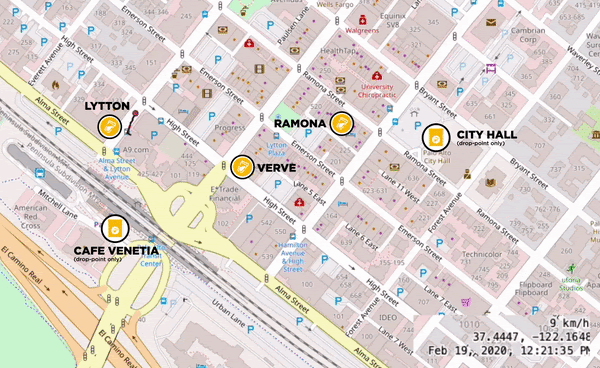
A cluster of local cafes and drop-off points
City Governments, Universities and NGOs Played a Critical Role in Galvanizing Momentum
Usership, especially early on, is directly tied to awareness. Data is most informative at higher volumes. The City of Palo Alto’s Zero Waste team was instrumental in identifying retail partners for the Pilot and educating their network, including zero waste leads in neighborhoods, about the pilots. The City of San Francisco’s Department of the Environment team was also engaged and eager to learn more about reusable cup solutions, especially in the face of proposed regulations and ordinances. The non-profit organization UPSTREAM made key introductions to city officials and shared essential information regarding upcoming ordinances and policies. The network effect is real. By engaging these organizations and their respective communities, our reach multiplied, attracting more pilot participants, thus gathering more data to optimize systems and prepare for the mass market.
The success of the pilots was built on the foundations of collaboration, which engaged diverse stakeholders and enabled agile and quick responses to feedback. COVID-19 brought unforeseen challenges and intensified the question, how can we maintain customer trust with reusable cups? Throughout the pilots, the reusable solutions adhered to rigorous washing protocols, including one team utilizing an off-site industrial facility to ensure the strictest hygiene standards were maintained. The pandemic has further emphasized the importance of sanitation and health, and the critical need to communicate these elements effectively to customers.
Moving forward, collaboration among diverse stakeholders is essential to ensure that innovative new systems of consumption can bring convenience and delight, while reducing the environmental footprint of our daily habits. The NextGen Consortium will continue to work with the Cup Challenge winners, as well as other promising cup innovations, to advance their solutions, while simultaneously strengthening and building the cup recovery ecosystem as a whole. This includes exploring new processes and working with waste collectors, materials recovery facilities, municipalities, and paper mills, among others, to explore the opportunities around cup recycling and composting. Our pilots in the San Francisco Bay Area provided invaluable feedback on how we can collectively enhance the drinking experience in a way that stakeholders (and the environment) can feel good about. And we’re excited to continue to accelerate the future of more sustainable cups.
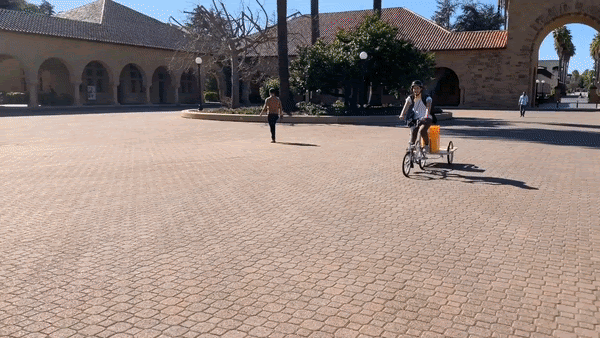
CupClub’s Cup Chariot in action on Stanford University’s campus
The Journey to Innovate How We Drink on the Go: 2 Years into the NextGen Consortium
February 20, 2020

This week, we hit a major milestone nearly two years after we launched the NextGen Consortium, our multi-year journey to solve for the waste associated with to-go cups: four of the winners of the NextGen Cup Challenge are piloting their solutions in cafes in the Bay Area.
After a six-month innovation challenge that identified 12 promising sustainable cup solutions out of hundreds of submissions, the hard work began to help innovators scale their solutions to address the global waste challenge while creating an equal or better customer experience. A six-month Accelerator provided six winning companies with mentorship, networking, and exposure to the end-of-use recovery systems their solutions need to navigate. And this week we are thrilled to start putting some of those cups to the test in the real world.
Two winning reusable cup innovators from the NextGen Cup Challenge — CupClub and Muuse — will start piloting their “smart” cup systems in Palo Alto and San Francisco respectively over the coming weeks. While Muuse is piloting a cup made of stainless steel, CupClub is using a cup made of polypropylene, demonstrating the diversity of material solutions out there. Footprint and PTT MCC Biochem Company Limited will also begin piloting their recyclable and compostable fiber cup solutions this month.
The beginning of this journey in 2018 coincided with a time when the movement to stop waste generated by single-use packaging began to take hold. We launched a Consortium to leverage the power of the world’s biggest food and beverage brands (Starbucks, McDonald’s, Taco Bell, KFC, Pizza Hut, Wendy’s, The Coca Cola Company, and Nestlé are all partners in the NextGen Consortium) and to create a market signal to drive scalable solutions for recyclable and compostable cups. And while expanding the recycling of food packaging is still a critical and primary focus of this ambitious endeavor, the dark horse in this race has been reusable and refillable cup systems.
We are seeing a growing demand from consumers and policy makers – and therefore an opportunity for brands – to completely rethink how we deliver products. And eliminating the need for single-use packaging in the first place is part of the suite of tools that can reduce waste and climate impact. From “naked” stores with no packaging to tech-enabled reusable packaging that tracks and recirculates items, sometimes with a consumer incentive, these models are growing. And cups are the next frontier, with a goal of making reusable cups as convenient as single-use. With these emerging cup models, consumers can simply get a cup at the cafe, drop it off at drop spots around the city or return them to the cafe for their next use. Companies like CupClub, Muuse, ReCup and others also work with the cafes and/or offsite washing facilities to collect and sanitize the cups.
Designing reuse models that can work in the complex ecosystems of a Starbucks or McDonald’s and creating an optimal customer experience across the US is no small task. Our testing and pilots over the last year have helped us identify pitfalls that have made past ideas fail. Innovation is a messy, iterative process and often failure leads to learnings, and learnings lead to success. Through the public-facing pilots launching this week, we are testing the cup’s technical feasibility, business model viability, user desirability and circular resiliency, among other things.
Lessons learned from these trials will be shared with NextGen Consortium partners, further honing and testing their systems to bridge the gap between prototyping and in-market testing and broader rollouts.
We see a bright future for pioneers in the reuse revolution like NextGen Cup winners CupClub, Muuse, and ReCup. We are equally excited to watch the innovation flood gates open thanks to the market signal created by the global brands in the NextGen Consortium coming together to find new solutions. We are seeing an unprecedented number of promising market entrants in reusable cup models. While we don’t yet know which models or businesses will be able to meet the operational needs and scale of today’s marketplaces, we know that the NextGen Consortium has been successful at bringing talent to the table. Just as ride-sharing, e-commerce and smart-devices have disrupted legacy business models that had dominated for many years, beverage containers and cups are ripe for the new models that help us improve the drinking experience without the negative consequences of today’s throwaway culture.
To advance the circular economy, we need the space to make and learn from mistakes and to bring together unlikely bedfellows to enable systems change. Today, we are at a tipping point, with an increased sense of urgency to address the global crises of climate change, ocean plastic pollution, and waste. We have the building blocks to scale a solution for cups, and can leverage and build upon the NextGen model to design out waste. First up it’s the cup, but the opportunities for pushing the bounds of sustainable design are endless.
Bringing the NextGen Cup to Life
November 18, 2019
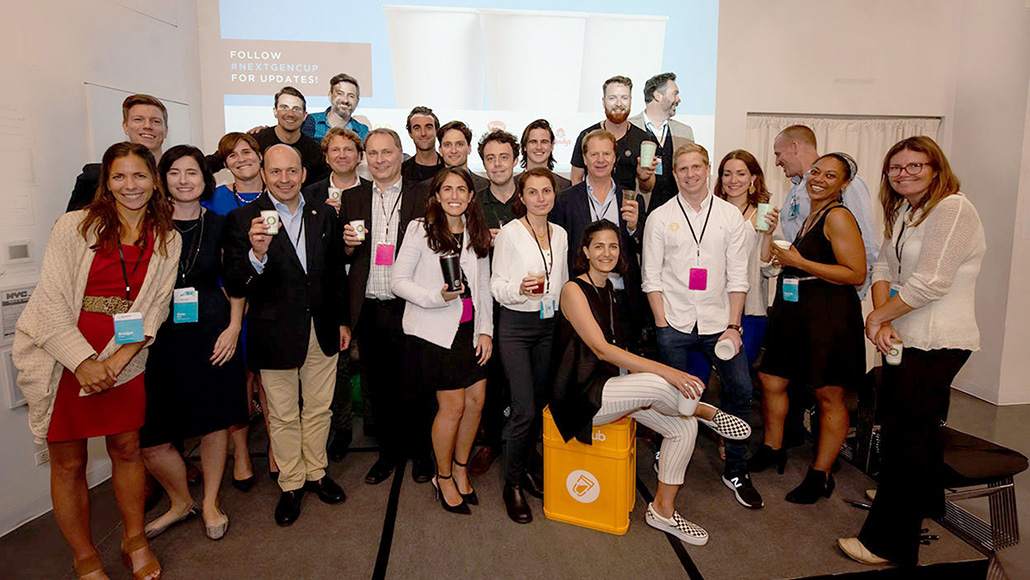
From 480 innovative ideas, to live prototyping, to preparing for pilot readiness and beyond, these next generation cups are paving the way for a waste-free future.
The NextGen Consortium is a global initiative convened by Closed Loop Partners’ Center for the Circular Economy. Starbucks and McDonald’s are founding partners of the Consortium, together with supporting partners The Coca-Cola Company, Yum! Brands, Nestlé and Wendy’s, as well as WWF as an advisory partner. OpenIDEO is the Consortium’s innovation partner.
The NextGen Consortium is working to change the future of beverage consumption. Together, brands, industry experts, and innovators are aiming to bring a waste-free to-go cup to market. With 250 billion fiber to-go cups produced annually, the majority of which end up in landfills today, this is not a small task that one stakeholder can solve alone. And that is the spirit in which the multi-brand NextGen Consortium was formed, launched by Closed Loop Partners in 2018 to advance the design, commercialization, and recovery of sustainable food packaging alternatives.
NextGen Cup is the Consortium’s first initiative, which began with an open call for solutions from around the world to redesign the fiber cup so that it’s fully recoverable at a global scale. Twelve winning teams were selected from the 480 submissions, and six of those teams recently completed an accelerator focused on getting their solutions ready to go to market. The accelerator led to significant progress for each of the teams, as they move along the journey from concept to tangible solution—Accelerator teams have now tested their solutions in a live environment, developed scalable manufacturing plans with 1-3 year rollouts, and have made improvements to their cup design to meet specific circular design criteria.
As we reflect on the learnings of brands, innovators, experts, and designers coming together to tangibly move the needle on a global issue, there are three conditions that have continuously contributed to measurable progress.
One: Collective brand investment
Why was this a collective effort, rather than one spearheaded by a single brand alone? Creating and scaling the next generation fiber cup for global recovery or reuse brings a host of challenges throughout the value chain.
From material choice, to cup design, to barista and customer experience, to integration with waste recovery streams (and much, much more), each component must be carefully designed, tested, and prototyped prior to piloting to ensure the solution can perform to the necessary quality and standards.
The NextGen Consortium was intentionally designed to be collaborative, both across the NextGen Consortium brands, and with the solutions themselves. The strategy behind this was two-fold:
- It’s faster together: Pre-competitive collaboration allows these brands to come together and share insights, learnings, and resources, making for a richer knowledge ecosystem overall. Similarly, cross-brand partnerships can send a unified signal to the market; for example, incentivizing wider adoption of sustainable materials or encouraging recovery systems to collect cups. By looking at multiple concepts at once, all stakeholders can move forward faster, including the teams themselves. Shared feedback mechanisms lead to enhanced learning for all involved.
- It’s less risky together: As partners and innovators learn, experiment, and work together across a number of concepts and concept types, all participants receive a clearer picture of what works through shared learnings and aggregated needs. With time and cup solutions iterations, the Consortium can work to mitigate any risks around introducing new concepts to market.
Two: Controlled prototyping experiences
In June 2019, the NextGen Circular Business Accelerator teams conducted live in-context prototyping at three different Google campus cafes in the South San Francisco Bay Area.
The goals of which were to:
- Accelerate learning: Prototyping helps teams learn faster and identify areas in need of development by testing solutions in an environment that is as close to a real market as possible.
- Test the whole system or a single hypothesis: Product and service systems can have a lot of interdependent moving parts. Prototyping is a low-risk way of testing how all of those parts work (or don’t work) together. It’s also useful for testing out a new feature or hypothesis that a team might have.
- Learn from users: Seeing first hand how users (coffee drinkers, restaurant workers, etc.) interact with and react to the solution is invaluable. The ability to hear their comments, answer and ask questions in real time is an important part of the process.
- Decrease risk: If a part of a solution does not work, it’s useful for teams to learn this early while the stakes are lower and while they still have the opportunity to incorporate what they learn into the next iteration of the product.
Choosing Google campuses as the prototyping location was a specific design choice. The closed environment of a campus approximates a high traffic retail cafe while offering the benefits of being able to control for key variables.
Cup teams had the opportunity to learn from a highly engaged group of users, and leverage Google’s network of micro-kitchens to explore multiple iterations of their solutions at the same time. Maintaining control across key variables provided teams with the opportunity to develop a prototyping plan that focused on the needs unique to their specific cup solution. For instance:
- Footprint was testing lid use and performance.
- Colombier was looking to compare different coating applications on their cups.
- CupClub wanted users to try out the UI/UX of their mobile application.
Three: A niche and specialized accelerator
Cup design is incredibly technical. From the integrity and safety of the cup itself, to the ability for baristas and users to handle them with ease, to becoming truly waste-free, constant attention to each and every one of these details (plus many more) required the development of a set of specialized metrics and tracking specific to this ecosystem.
For example, during the Google prototyping, teams were specifically evaluating:
- User experience: Teams explored first-hand how beverage drinkers interact with and react to their solutions. Testing was conducted in a variety of ways including design research interviews, surveys, observations and comments, and deep-dive question sessions.
- Barista experience: Many teams had yet to see and understand how their cups do or do not work within the barista context. This was a key initial exploration to determine how well the cup is nesting / de-nesting, holding up to certain types of drinks being made, as well as overall impressions from baristas on each cup.
- Performance: Teams measured general performance of each cup solution, including: how long cups must hold liquid at this location based on user habits, how well the cup regulated temperature either with / without a sleeve, how well the cup stacked, stored, nested and de-nested within the space, overall lid performance, etc.
- Disposal: Teams tracked where the cups ended up in bins across campuses in order to better understand what signifiers (written, visual, verbal, etc.) helped to inform consumers of the proper disposal method.
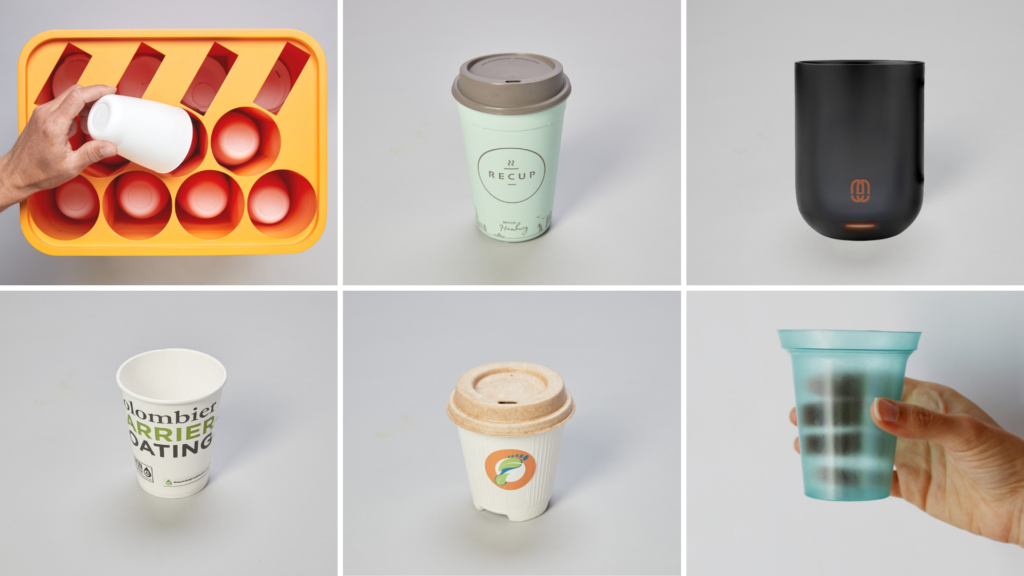
Top row: CupClub, ReCup, Muuse. Bottom row: Colombier, Footprint, SoluBlue.
Where cups end up after-use is a critical part of the journey and a key focus of the NextGen Consortium’s work. By connecting upstream cup innovation to downstream recovery infrastructure, and focusing on understanding and integrating new cup solutions within existing recovery systems, the NextGen Consortium aims to keep the valuable materials in cups in circulation. During the accelerator, teams visited and ran their new cup solutions through materials recovery facilities (MRFs) to see first-hand what happens to their cups at end-of-use. They examined the value of their cup materials post-processing to better understand the market incentives for recycling or composting, which are ultimately driven by end markets.
The benefits of focusing on this very specific world of sustainable cups continued to ring clear as teams graduated from the accelerator and pitched their solutions live to NextGen Consortium Partners and a group of investors during Climate Week NYC, in September 2019. When it comes to storytelling and understanding the breadth of solutions available within the fiber to-go cup ecosystems, seeing each of the solutions side by side helped investors, partners, and teams understand the value of each of their approaches. The cup solutions included:
Reusable cups and cup systems solutions:
- CupClub: A returnable cup ecosystem, providing a service for drinks. Think bike sharing, but for cups.
- ReCup: A deposit system for reusable cups. Rent a cup and return it to any participating partner shop. No cleaning of the cup or carrying around required.
- Muuse: A deposit-based platform for smart, reusable beverage packaging, connecting their cups–and third party products–to Internet of Things technologies. (Formerly Revolv)
Single-use fiber cups and liners solutions:
- Colombier: A recyclable and compostable barrier for paperboard cups.
- Footprint: Cups, lids and straws that are fully formed fiber-based solutions, with an aqueous-based coating that is recyclable and compostable.
Innovative new materials:
• Solublue: Plant-based, food grade and non-toxic products that biodegrade after use.
What’s next for the NextGen Cup?
As each of the six teams stepped off the stage during the final accelerator pitch event, the NextGen Consortium entered the next phase of this work: pilot readiness testing.
After the initial prototyping at Google campuses, select teams will now work to increase the size and complexity of their testing locations, looking at universities and offices, among other locations. Additionally, these teams will now begin to prototype alongside select teams from the NextGen Consortium’s “Advanced Solutions Program,” later-stage teams from the NextGen Cup Challenge that did not require the initial accelerator programming. As these teams work to reach market readiness, their greatest need is additional data points that will prove their concept’s ability to operate at scale.
The pilot readiness tests aim to provide much of that data and help setup teams for next steps around scalability. In parallel, the NextGen Consortium will continue its work convening experts and identifying opportunities to align new cup designs and materials with the infrastructure like MRFs, paper mills, and other recyclers that would process them at end-of-use.
From 480 innovative ideas to live prototyping to preparing for pilot readiness and beyond, these next generation cups are paving the way for a waste-free future. These are not solutions that will be ready overnight and require multiple layers of testing and iteration. That’s why NextGen Cup has a multi-stage, multi-year approach to identifying, testing, and scaling sustainable cup solutions to integrate into the global supply chain.
NextGen Cup is designed to both acknowledge the complex journey of the cup, from design through to cup recovery after-use, and accelerate it by de-risking the process in its collective efforts and creating methods for effective prototyping and pilot readiness.
A Linear Take-Make-Waste Economy Has Prevailed For The Last 50 Years, But The Circular Economy Is Where Value Will Be Created In The 21st Century
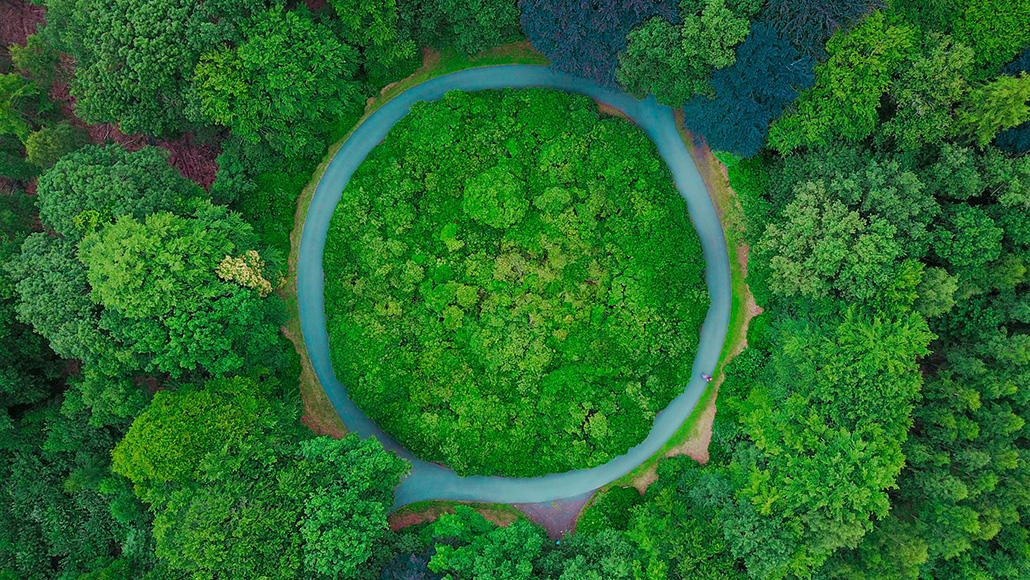
This week, we hit a major milestone nearly two years after we launched the NextGen Consortium, our multi-year journey to solve for the waste associated with to-go cups: four of the winners of the NextGen Cup Challenge are piloting their solutions in cafes in the Bay Area.
After a six-month innovation challenge that identified 12 promising sustainable cup solutions out of hundreds of submissions, the hard work began to help innovators scale their solutions to address the global waste challenge while creating an equal or better customer experience. A six-month Accelerator provided six winning companies with mentorship, networking, and exposure to the end-of-use recovery systems their solutions need to navigate. And this week we are thrilled to start putting some of those cups to the test in the real world.
Two winning reusable cup innovators from the NextGen Cup Challenge — CupClub and Muuse — will start piloting their “smart” cup systems in Palo Alto and San Francisco respectively over the coming weeks. While Muuse is piloting a cup made of stainless steel, CupClub is using a cup made of polypropylene, demonstrating the diversity of material solutions out there. Footprint and PTT MCC Biochem Company Limited will also begin piloting their recyclable and compostable fiber cup solutions this month.
The beginning of this journey in 2018 coincided with a time when the movement to stop waste generated by single-use packaging began to take hold. We launched a Consortium to leverage the power of the world’s biggest food and beverage brands (Starbucks, McDonald’s, Taco Bell, KFC, Pizza Hut, Wendy’s, The Coca Cola Company, and Nestlé are all partners in the NextGen Consortium) and to create a market signal to drive scalable solutions for recyclable and compostable cups. And while expanding the recycling of food packaging is still a critical and primary focus of this ambitious endeavor, the dark horse in this race has been reusable and refillable cup systems.
We are seeing a growing demand from consumers and policy makers – and therefore an opportunity for brands – to completely rethink how we deliver products. And eliminating the need for single-use packaging in the first place is part of the suite of tools that can reduce waste and climate impact. From “naked” stores with no packaging to tech-enabled reusable packaging that tracks and recirculates items, sometimes with a consumer incentive, these models are growing. And cups are the next frontier, with a goal of making reusable cups as convenient as single-use. With these emerging cup models, consumers can simply get a cup at the cafe, drop it off at drop spots around the city or return them to the cafe for their next use. Companies like CupClub, Muuse, ReCup and others also work with the cafes and/or offsite washing facilities to collect and sanitize the cups.
Designing reuse models that can work in the complex ecosystems of a Starbucks or McDonald’s and creating an optimal customer experience across the US is no small task. Our testing and pilots over the last year have helped us identify pitfalls that have made past ideas fail. Innovation is a messy, iterative process and often failure leads to learnings, and learnings lead to success. Through the public-facing pilots launching this week, we are testing the cup’s technical feasibility, business model viability, user desirability and circular resiliency, among other things.
Lessons learned from these trials will be shared with NextGen Consortium partners, further honing and testing their systems to bridge the gap between prototyping and in-market testing and broader rollouts.
We see a bright future for pioneers in the reuse revolution like NextGen Cup winners CupClub, Muuse, and ReCup. We are equally excited to watch the innovation flood gates open thanks to the market signal created by the global brands in the NextGen Consortium coming together to find new solutions. We are seeing an unprecedented number of promising market entrants in reusable cup models. While we don’t yet know which models or businesses will be able to meet the operational needs and scale of today’s marketplaces, we know that the NextGen Consortium has been successful at bringing talent to the table. Just as ride-sharing, e-commerce and smart-devices have disrupted legacy business models that had dominated for many years, beverage containers and cups are ripe for the new models that help us improve the drinking experience without the negative consequences of today’s throwaway culture.
To advance the circular economy, we need the space to make and learn from mistakes and to bring together unlikely bedfellows to enable systems change. Today, we are at a tipping point, with an increased sense of urgency to address the global crises of climate change, ocean plastic pollution, and waste. We have the building blocks to scale a solution for cups, and can leverage and build upon the NextGen model to design out waste. First up it’s the cup, but the opportunities for pushing the bounds of sustainable design are endless.
Six Companies Graduate from the NextGen Circular Business Accelerator Ready to Scale Their Sustainable Cup Solutions
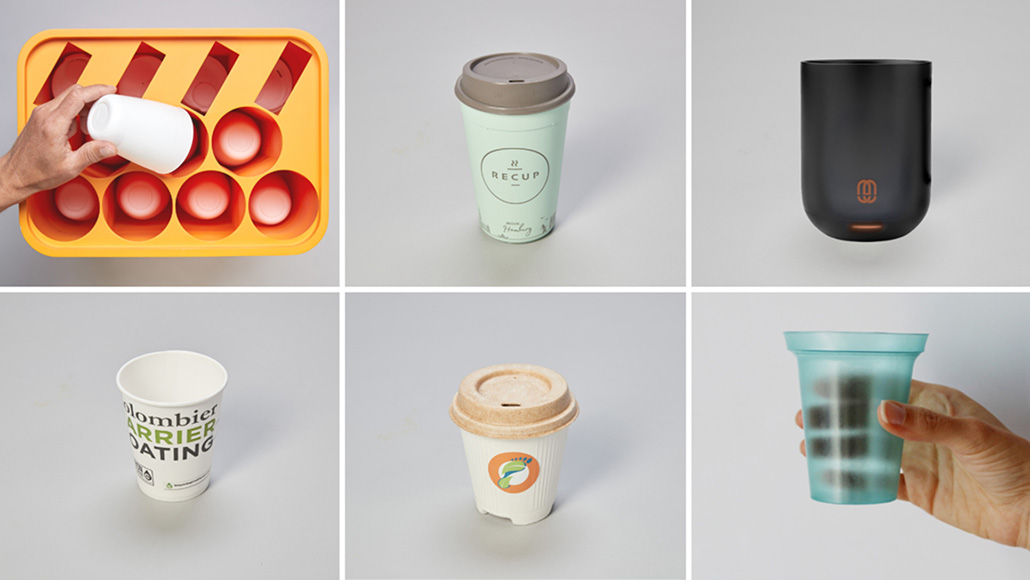
The NextGen Consortium, a pre-competitive collaboration managed by Closed Loop Partners in partnership with Starbucks and McDonald’s, accelerates towards a more circular cup system.
Contact: [email protected]
September 25 – NextGen Consortium Partners, investors, and other stakeholders convened during Climate Week in New York City for a Demo Day in which six participants in the NextGen Circular Business Accelerator showcased their manufacture-ready prototypes and pitch-ready business plans for growing their sustainable cup solutions.
The Accelerator follows Closed Loop Partners’ announcement of 12 NextGen Cup Challenge winners in February 2019. Six winning teams entered the NextGen Circular Business Accelerator, launched in partnership with global design firm IDEO to help companies further refine their cup solutions through rapid learning and iteration. The diverse solutions include cutting-edge plant-based materials, new innovative liners for cups, and reusable cup systems that redesign the fiber to-go cup so that it is more widely recoverable or remains in circulation for multiple uses. The six teams participating in the Accelerator are Colombier, CupClub, Footprint, Muuse, RECUP, and SoluBlue.
During the rigorous, six-month Accelerator program, companies accelerated their learnings through live in-context prototyping across four distinct Google campus locations, each housing multiple cafes. Progress for each cup solution was measured across four key categories: customer experience, server experience, performance, and disposal. Companies were able to see first-hand how customers and servers interact with their cups in a restaurant-like environment, capturing real-time feedback in a low-risk setting and identifying areas for refinement.
Companies also visited materials recovery facilities and explored the recovery side of the cup value chain, learning about the systems and infrastructure in place to ensure that their solutions are in alignment. Additionally, companies studied the value of materials recovered post-processing of their cups in order to make the economic case for more circular approaches.
Throughout the Accelerator, companies gained invaluable feedback through direct engagement with NextGen Consortium Partners, including founding partners Starbucks and McDonald’s, supporting partners The Coca-Cola Company, Yum! Brands, Nestlé, and Wendy’s, advisory partner WWF, and innovation partner IDEO. Feedback included insight into what it would take to roll out their solutions at a large scale.
“We are proud of the NextGen collaboration underway with so many companies championing greener cup technologies. We applaud Closed Loop Partners’ continued, on-track progress to determine what’s most viable, and we are excited for our own customers to try greener cups in our stores in the near future.”
John Kelly, senior vice president, Global Public Affairs & Social Impact at Starbucks
The companies were also welcomed behind the scenes of a McDonald’s restaurant to better understand how cups work within a store’s layout and staff operations.
“We were thrilled to have participants in the NextGen Circular Business Accelerator experience. Having these next gen solutions in our restaurants to see first-hand how our crew members manage through our restaurant operations is an important step. Compatibility with the fast pace of a QSR setting is critical, and it was great to see Accelerator teams jump at the opportunity to better understand these in-restaurant conditions. These cup solutions are helping shape the future of packaging, and we want to set them up for success while keeping valuable materials in circulation and, importantly, out of landfills and our oceans.”
Marion Gross, Senior Vice President and Chief Supply Chain Officer, McDonald’s USA
“Seeing how far participants in the NextGen Circular Business Accelerator have come is truly rewarding. The NextGen Consortium will continue to work with winning teams to ensure that when their solutions do enter market at scale they’re set up for success and recoverability.“
Kate Daly, Managing Director of the Center for the Circular Economy at Closed Loop Partners
The other six winners of the NextGen Cup Challenge, which are later-stage in their development, are working with the NextGen Consortium to identify in-market piloting opportunities in regions across the globe. Some participants in the NextGen Circular Business Accelerator are also expected to announce in-store pilots as early as 2020.
The Cup Challenge and the NextGen Circular Business Accelerator are just one part of the NextGen Consortium’s efforts to address single-use food packaging waste globally by advancing the design, commercialization, and recovery of food packaging alternatives. The Consortium is also focused on infrastructure and consumer engagement, supported by stakeholder collaboration across the value chain.
“Watching the aggregation of innovative ideas turn into real progress has been exciting to watch. Now we’ll look to the members of the NextGen Consortium to take these solutions into the marketplace and watch real change happen.”
Erin Simon, Director, Sustainability R&D, World Wildlife Fund
About NextGen
Each year, an estimated 250 billion fiber to-go cups are distributed worldwide. Most of these are not recyclable or compostable. The NextGen Consortium and Cup Challenge launched in 2018 to bring together entrepreneurs, industry, and recyclers to identify and commercialize the next generation of recyclable and/or compostable cups. Closed Loop Partners, Starbucks, McDonald’s, The Coca-Cola Company, Yum! Brands, Nestlé and Wendy’s invite the industry to join this effort to identify a global solution to this shared challenge.
About Closed Loop Partners
Closed Loop Partners is an investment firm that invests in sustainable consumer goods, recycling, and the development of the circular economy. Investors include many of the world’s largest consumer goods companies and family offices interested in investments that provide strong financial returns and tangible social impact. In 2018, Closed Loop Partners launched the Center for the Circular Economy, a New York City-based collaboration center for innovators to commercialize products, services, and technologies that are leading the transition from a linear take, make, waste economy to a restorative one in which materials are shared, re-used, and continuously cycled. Learn more at www.closedlooppartners.com.
About McDonald’s
McDonald’s is the world’s leading global foodservice retailer with over 37,000 locations in over 100 countries. Over 90 percent of McDonald’s restaurants worldwide are owned and operated by independent local business men and women. This year McDonald’s announced a series of commitments demonstrating how it will use its Scale for Good to positively impact the planet and the communities it serves. You can read more about McDonald’s Scale for Good initiatives here.
About Starbucks
Since 1971, Starbucks Coffee Company has been committed to ethically sourcing and roasting high-quality arabica coffee. Today, with stores around the globe, the company is the premier roaster and retailer of specialty coffee in the world. Through our unwavering commitment to excellence and our guiding principles, we bring the unique Starbucks Experience to life for every customer through every cup. To share in the experience, please visit us in our stores or online at http://news.starbucks.com or www.starbucks.com.
NextGen Consortium Partners
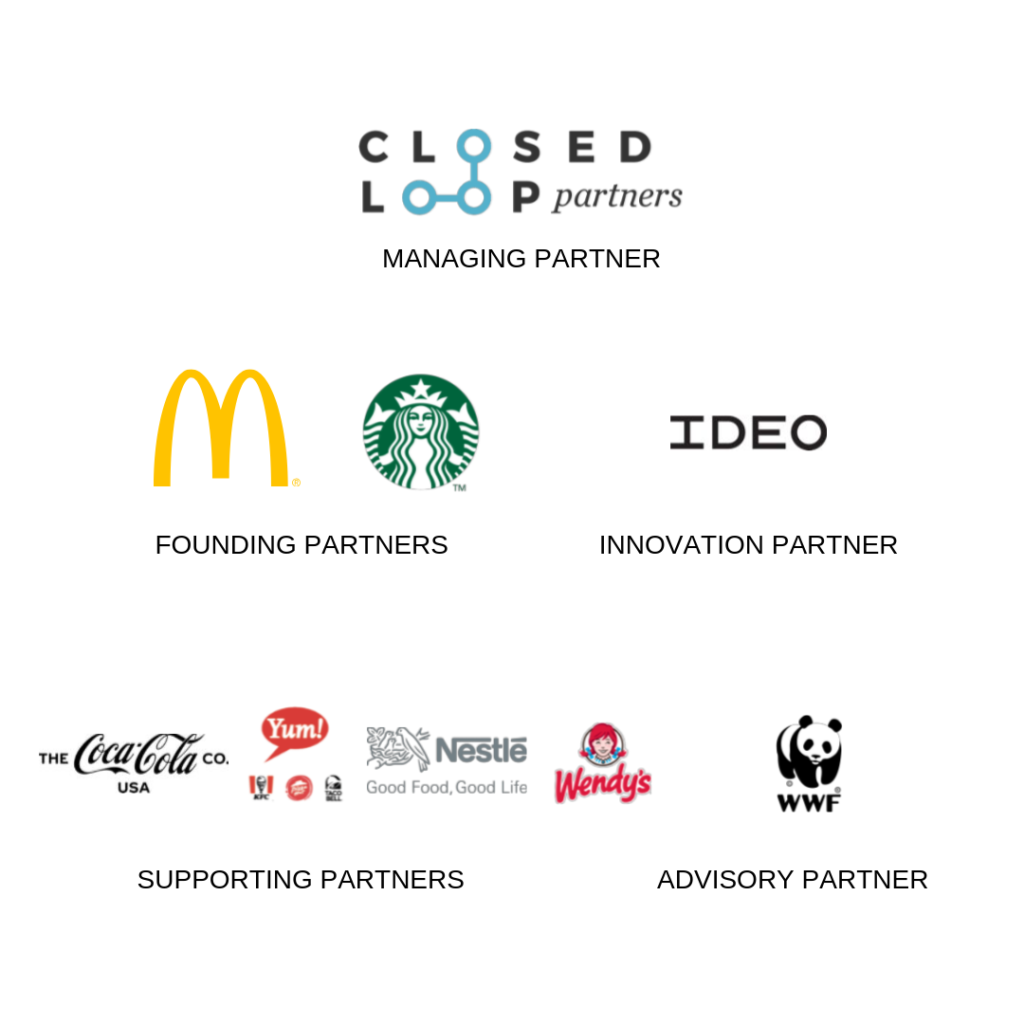
How to Use Design Thinking to Advance Systemic Change, One Cup at a Time
August 05, 2019
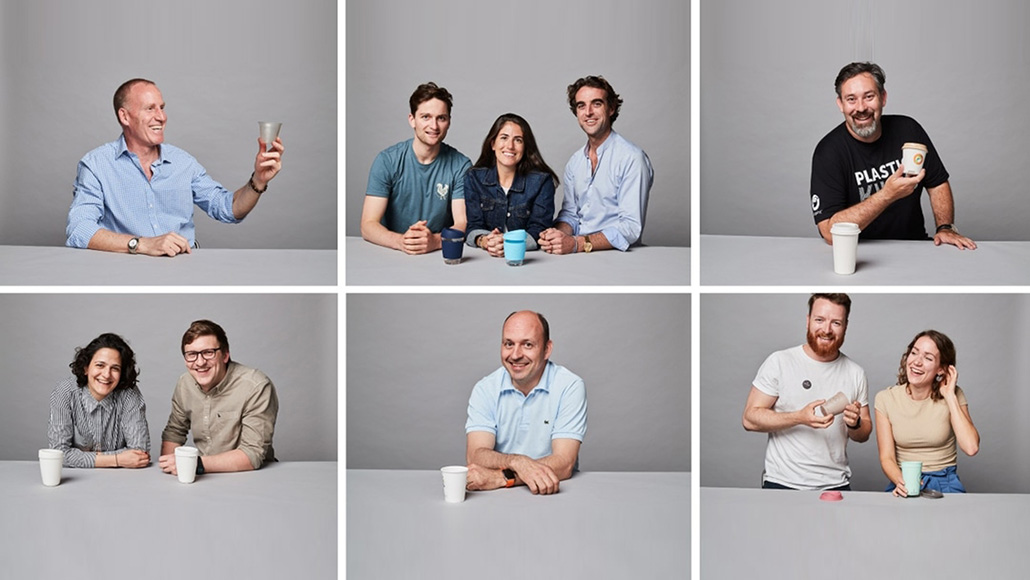
Amid burbling espresso machines and towering stacks of cups, six teams in the NextGen Circular Business Accelerator are taking waste-free cup solutions to the next level. Venturing back of house at restaurants and into the world of waste management, see how teams use five design thinking practices to advance solutions for a more circular future.
The NextGen Consortium is a global initiative convened by Closed Loop Partners’ Center for the Circular Economy. Starbucks and McDonald’s are founding partners of the Consortium, together with supporting partners The Coca-Cola Company, Yum! Brands, Nestlé and Wendy’s, as well as WWF as an advisory partner. OpenIDEO is the Consortium’s innovation partner.
If you’re looking for a systemic challenge in need of some new thinking, look no further than your morning cup of coffee. Worldwide, 250 billion to-go cups are produced each year, and there’s an increasing need for recoverable alternatives. Most fiber cups have a plastic liner to prevent leaks. The fiber and plastic are recyclable once separated, but limitations and inconsistencies in recycling infrastructure around the world mean that in most markets these materials aren’t easily recovered. The trouble is, as OpenIDEO Circular Program Lead Chris Krohn explains,
“When we have a systems design challenge, we can’t expect to solve it using the same approach that created the problem. It’s essential to understand the issue from perspectives across the entire value chain, and then work across that system to develop a holistic solution.”
In pursuit of some fresh ideas, Closed Loop Partners launched the NextGen Consortium: a multi-year partnership of food and beverage industry leaders that aims to address global single-use food packaging waste. Up first, the ubiquitous hot and cold, fiber-based, to-go cup. The NextGen Cup Challenge identified twelve innovators with the most promising cup solutions – from new cup liners to reusable cup systems. Of those, six winning teams (pictured above) joined the NextGen Circular Business Accelerator, an initiative to help prepare the teams for testing and scaling their solutions to meet the needs of today’s biggest brands and consumers worldwide.
Before rolling out new cup solutions in a real-world setting, it was essential for Accelerator teams to understand the customer needs, business realities, infrastructure challenges, and people at the core of the cup ecosystem. In a week-long design Bootcamp that took us behind counters and across the San Francisco Bay Area, OpenIDEO, with support from Closed Loop Partners, led teams through five design thinking practices to quickly surface new insights and inspiration. Try them out yourself the next time you’re working on a complex problem.
1. Center on a plan for informed, effective research
Design a fresh perspective. An essential part of the design thinking process is design research: exploring what people say, think, do and feel to help build human-centered solutions. This often means getting out into the field to meet people where they are, which helps us understand real needs and imagine what’s next. As Nina Montgomery, an IDEO design researcher, shared with NextGen Accelerator teams at the start of the Bootcamp,
“The power of design research is that—through empathy and inspiration—it is able to surface new thinking.”
Start with what you know. Before jumping into the field, it’s helpful to curate some background knowledge. We worked with each Accelerator team to compile insights from desk research—across internal documents, datasets, and market, competitor and business plan analysis—to get a sense of what was known and what we needed to test. Some teams, like RECUP from Munich, Germany, plan to roll out systems involving reusable cups, while others, like Solublue from London, UK, are building biodegradable cup solutions from new materials. Despite this diversity in business models, every team needed to know how consumers and distributors would respond to their particular cups. We also took into consideration the needs of Consortium Partners like McDonald’s and Starbucks to help identify any gaps and inform the key questions each team had to answer to set themselves up for scale.
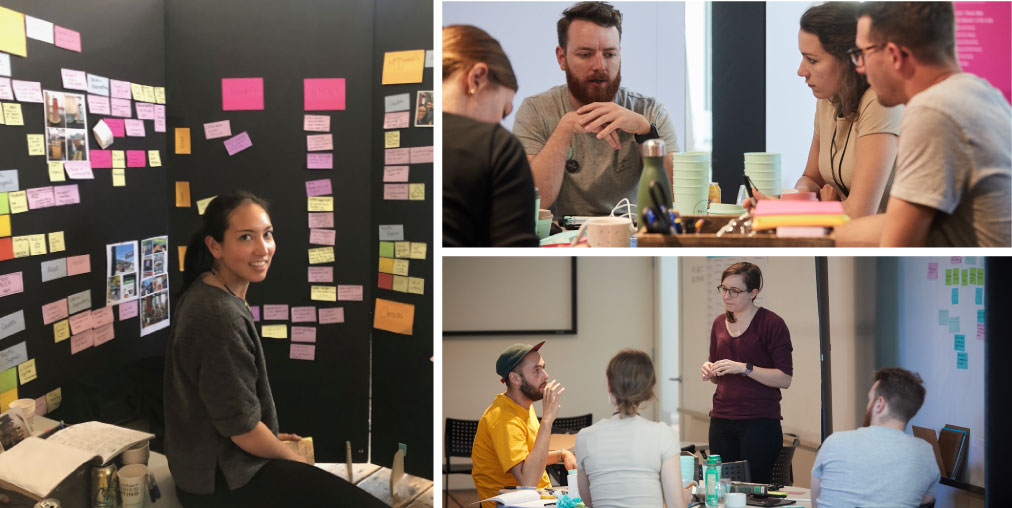
NextGen Circular Business Accelerator teams make a plan for their design field research.
Develop a research game plan. With this in mind, we kicked off the Bootcamp by developing a design research plan. This included deciding on research methods, team roles, and questions to ask in the field, and ensuring we were integrating research ethics. Building on background research, we helped Accelerator teams identify and schedule time to visit the kinds of people and places that would surface valuable, diverse insights about the to-go cup ecosystem. Together, we synthesized research questions in a discussion guide that was shared with each team member, ensuring that field research focused on what mattered most. Armed with a plan, a notebook, Sharpies, and lots of Post-Its, we were ready to hit the streets of San Francisco.
Try it:
- Explore a variety of design research methods in Design Kit.
- Focus in on your key research questions using this Design Research Discussion Guide.
2. Gain micro-level insights through observation
Watch and learn. That’s how, on a bright Tuesday morning, a group of IDEO designers and Accelerator entrepreneurs found ourselves attentively watching a stream of cups dance between hands and over counters at a San Francisco McDonald’s. Observation is a key method of design thinking. By taking a step back and looking carefully, we can better understand systems at a micro level.
At McDonald’s, observing employees interact with cups soon surfaced some fresh insights. To keep up with the lunch rush, cups must be easy to grab with one hand, nest well but also release easily from a stack, and communicate branding. Through observation, Accelerator teams quickly built empathy for the employees and identified how their new cups would or would not meet McDonald’s needs. By allowing us to observe their operations, McDonald’s was able to easily communicate their business realities and product requirements in a way that would have been impossible through words alone.
“Everyone knows McDonald’s, but how many people can say they’ve experienced the back of house logistics required to operate one? The Bootcamp provided opportunities like this that startups only dream about, and catapulted our growth potential in ways we’ll still be processing months later.”
Lizzie Horvitz, one of the Accelerator participants
Try it:
- Observation is simple. Grab a notebook, a pen, & scope out a good place to watch & listen.
- Find tips for getting started in this quick Design Research Field Guide from IDEO.
3. Uncover disconnects and trends with interviews and intercepts
Listen for gold. To fully understand what someone is thinking or feeling, we’ve found it’s often best just to ask. Building on our observations, we set up interviews with baristas, managers, and more, asking open-ended “how” and “why” questions that encouraged them to speak freely.
What we heard was a surprising amount of confusion around cup disposal best practices. In one coffee shop, baristas were told to compost cups, while the trash bins in the shop had signs instructing customers to recycle—both instructions contrasting with San Francisco waste management company Recology’s guidelines. User interviews helped teams identify pain points and systemic disconnects which would have been tough to spot without talking to the people on the ground.
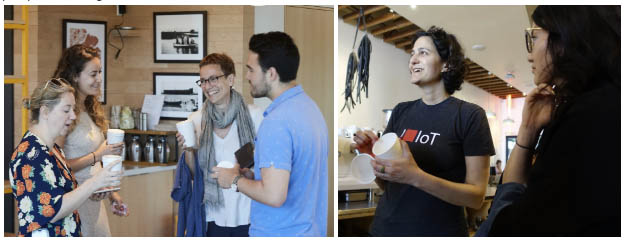
Teams gather user feedback on their cup designs and systems during intercepts and interviews.
Intercept for quick insights. The trouble with interviews: they can take time to set up. That’s why we also practiced intercepts— brief moments of connection with users that allowed us to capture impressions and test assumptions in real time. Conducting an intercept is as simple as walking up to a friendly face, introducing yourself, and asking a single important question.
The Footprint team—offering fully formed fiber-based cup solutions—tried out intercepts in a coffee shop, surveying customer opinions on their brown fiber cup vs. their more traditional white cup. The responses were intriguing. In general, millennials seemed to prefer the brown cup, describing it as “natural,” while older generations felt it looked “dirty.” By compiling responses, intercepts helped our teams quickly identify demographic trends and interests that would help define their future product offerings.
“Field research during the bootcamp showed us that there is potential to improve our cups and lids both for convenience and recyclability. We also got better insights into how logistics and incentives around the cup system might need to be adapted for the US market.”
Alexandra Gurstmeier of ReCup
Bring it all together. After every field research session, it’s important to debrief to ensure insights aren’t lost. With each Accelerator team, we’d synthesize—transferring notes from observations and interview guides onto post-its, sticking them up on a board, and grouping where we saw trends. This process helped the teams identify the essential flags, opportunities, and business considerations that surfaced in their research.
Try it:
- Use this Interview Guide to shape consumer conversations and ask strong questions.
- Fill out an Intercept Worksheet to get set up for these quick moments of connection.
4. See a challenge with fresh eyes through analogous experiences
Learn from others. Paradoxically, sometimes the best way to think differently is to seek what’s similar. Analogous research takes a look at different industries to find inspiration in the ways others have tackled similar challenges. During the Accelerator, we paired teams with organizations that have successfully worked through an issue our teams were currently facing. For example, the Solublue team—offering a plant-based, biodegradable cup solution—is currently preparing to ramp up its production. The team toured the Dandelion Chocolate factory for an inside look at how they set up and scaled their manufacturing process.
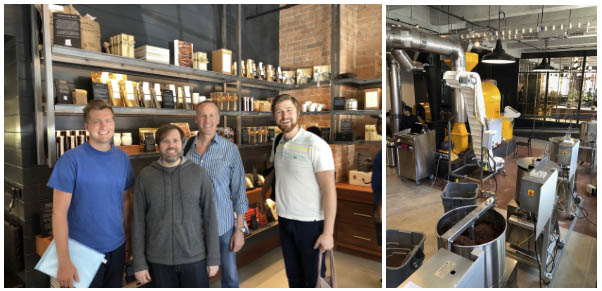
The Solublue team and IDEO design researchers explore the manufacturing systems of Dandelion Chocolate as analogous research.
Meanwhile, the CupClub team, which creates reusable cups people can pick up in a coffee shop and deposit at dedicated drop points around their city, found inspiration from an unusual source: rentable electric scooters. While cups and scooters may not seem to share much in common, CupClub learned from the Spin team how they managed the “economies” that popped up around their scooters, which provided quick cash for people willing to collect and recharge the scooters at home. This insight led to an interesting question for the CupClub team: how might we build economies of support around a reusable cup model that promote sustainability and job creation?
As the teams found, analogous research is a great way to gain a new perspective, learn from other’s struggles and successes, and help break through entrenched thinking.
Try it:
- Brainstorm: what other industries are tackling problems similar to the ones you are facing? What can you learn from their approach? Use this analogous inspiration exercise as a guide.
5. Map the existing infrastructure to define the path forward
Get real. To design sustainably, it’s essential to understand and integrate into the existing ecosystem that will touch a product over its lifecycle. Mapping how each team’s solution fit within the broader cup recovery infrastructure was crucial to ensure their cups would be fully recoverable down the line.
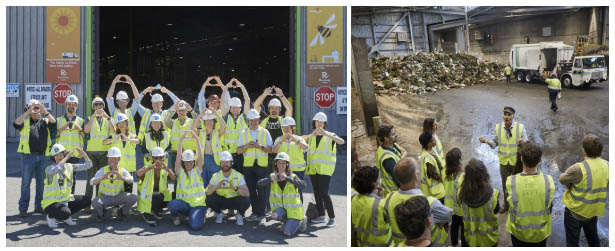
NextGen Circular Business Accelerator teams tour San Francisco’s waste recovery center, Recology.
Seek an informed perspective. Learning from experts, Accelerator teams toured waste management expert Recology’s facilities to better understand the technological capabilities and market forces affecting the local Bay Area recovery infrastructure. During the visit, teams had the opportunity to run their products through Recology’s recycling lines to gather real-time performance data. Teams also heard from Kate Daly, Managing Director at Closed Loop Partners, who shared a macro-perspective on global trends in recovery and reuse, and helped the teams think big picture—connecting upstream innovation to downstream recovery.
“Alignment between the design of cups and infrastructure is critical for capturing materials at every phase of a cup’s life cycle. It’s also important that as we continue to design for a better, more sustainable future, our infrastructure evolves too.”
Map the journey ahead. With these insights in mind, it was time to pull it all together. To get started, we helped teams consider their product journey, including all the people engaged along the way. The teams created a Post-It to represent every actor—from raw material producers and manufacturing technicians to corporate and distribution partners, consumers, and waste management experts—and made note of their specific needs as identified through research. Between actors, we drew lines to represent relationships: those that already existed, and those that each team needed to build in order to scale their solutions.
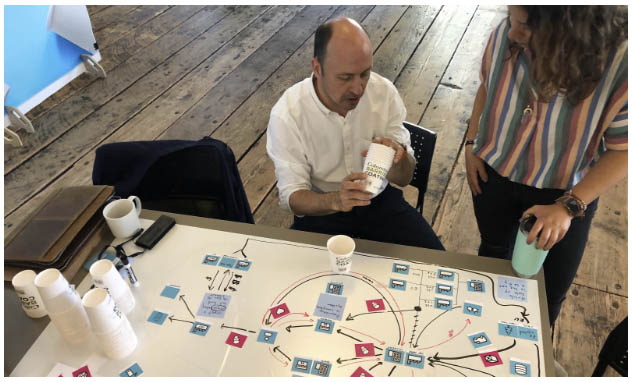
Ecosystem mapping with Henrik Björnberg, Chair of Colombier Group. Winning Cup Category: Innovative Cup Liner
The takeaways from the ecosystem mapping process set the Accelerator teams up with an actionable roll-out plan that identified their place within the existing infrastructure and who they needed to build partnerships with in pursuit of a fully circular, sustainable cup system.
Try it:
- Try out this product journey mapping exercise, then imagine new partnerships that could strengthen your network.
All together, these five design thinking practices helped our NextGen Accelerator teams gain a deeper understanding of the complex micro systems and macro infrastructure their products need to serve, while enabling Consortium Partners to quickly surface business realities and sticking points, helping to de-risk and accelerate the roll-out of new cups worldwide.
While not everyone can embark on a research sprint through futuristic waste recovery facilities and McDonald’s back-of-house experiences, anyone can apply design thinking practices to uncover fresh insights.
When addressing a problem that requires systemic change—prep, observe, interview, seek analogous inspiration, and map it out. The result could be some powerful new thinking, or perhaps even the holistic, circular cup of the future.
Investable Opportunities to Stem the Tide of Ocean Plastic Pollution and Build a Circular Economy

With only 9% of the world’s plastics getting recycled and global plastics demand forecasted to triple by 2050, we’re in desperate need for tangible, investable solutions to avert a crisis. Where ten years ago, the urgent need to broach this subject was met with resistance, today the conditions are altogether different.
Across the globe, movements such as Break Free From Plastic and legislation like the EU’s Circular Economy Action Plan have galvanised the public. Shocking images of sea turtles maimed by straws or statistics about there being more plastic than fish in the sea by 2050 have struck a chord.
It’s clear we must rethink our current leaky, linear system and shift to something more circular. We need a system that’s consciously designed to use less materials in the production and delivery of products and that keeps materials in circulation at their highest value for as many generations as possible, if not infinitely. This way we can reduce our waste and our extraction of raw materials.
Sometimes plastic is the most appropriate material to serve a purpose, given its particular properties, other times it’s not. There is no silver bullet approach. We need to invest in both near term solutions and long term solutions with clear paths to scaling to tackle the problem of ocean plastic pollution and reduce overall environmental impacts.
The good news: we’re already seeing clear, investable solutions that can shift us in the right direction.
There are at least 60 technology providers developing transformational technologies that purify, decompose, or convert waste plastics into renewed raw materials in North America, representing a $47 billion opportunity in North America alone. Many of these technologies mean there is no limit to the number of times plastics can be recycled, thereby helping us to shape a more circular economy for plastics.
Other companies are exploring innovative new delivery models or alternative materials science. Their outputs could supersede the need for plastic packaging altogether, whether through vending machines that dispense exact amounts of product into reusable containers like Algramo, new feedstocks replacing styrofoam packaging like TemperPack or through hyper-compostable, edible straws made of sustainably harvested seaweed like Loliware.
Large banks and brands are getting on board too, recognizing the need for change. Institutions like Goldman Sachs, Citi, Comerica Bank and Engie have co-invested in our funds in order to catalyze the development of the circular economy.
If we’re to stem the tide of plastic pollution in our oceans, it’s critical that we invest across the value chain and in companies that are rethinking the system for a more sustainable future. With the current enabling conditions, from policy to consumer engagement, now is the time to do it.
This blog was inspired by the discussion in Confluence Philanthropy‘s webinar on Exploring Investor Solutions to Restore the Ocean, which I participated in with Mark Spalding, President of The Ocean Foundation, Conrad MacKerron, Senior Vice President of As You Sow, and Angela Howe, Legal Director of Surfrider Foundation.
Sustainable Packaging Coalition and Center for the Circular Economy at Closed Loop Partners Announce Winner of the FlexPack Recovery Challenge
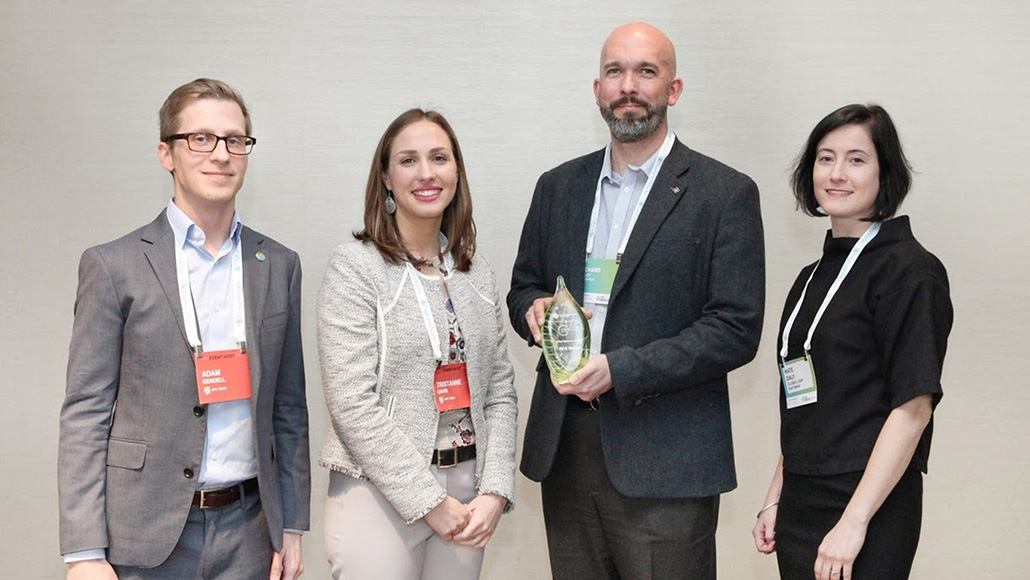
Start-ups from across the globe showcased their recovery technologies for a fast-growing category of hard-to-recycle flexible plastic packaging, and one winner was selected to join a mentorship program with the Sustainable Packaging Coalition & Closed Loop Partners.
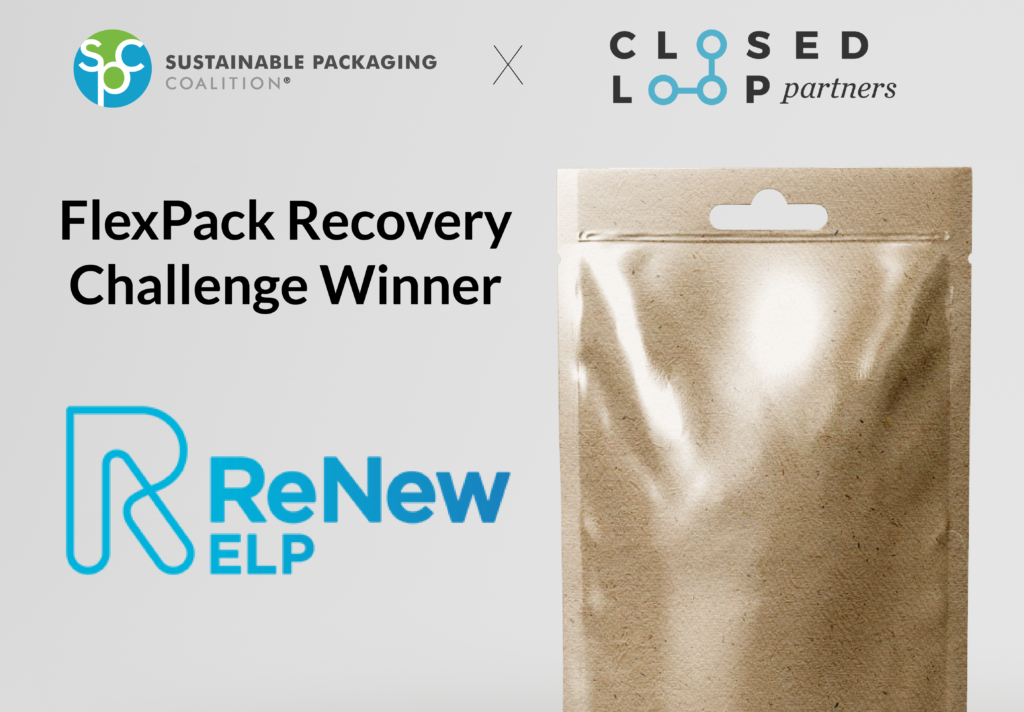
CHARLOTTESVILLE, VA and NEW YORK, NY — the Center for the Circular Economy at Closed Loop Partners and the Sustainable Packaging Coalition (SPC) have announced the winner of the FlexPack Recovery Challenge: ReNew ELP.
In October 2018, the SPC and the Center for the Circular Economy at Closed Loop Partners launched the FlexPack Recovery Challenge, an open competition for innovators, entrepreneurs, and start-ups to submit new ideas for reprocessing technologies capable of beneficially recovering multi-material flexible packaging waste.
Five finalists were selected by a panel of judges from the SPC and the Center for the Circular Economy at Closed Loop Partners staff, as well as with input from industry advisors. Each finalist participated in the SPC’s spring conference SPC Impact and presented to an audience of major brands, plastic manufacturers, and packaging suppliers, including members of the SPC’s Industry Leadership Committee on Multi-Material Flexible Recovery, on how their technologies can beneficially recover the embodied environmental investment within multi-material flexible packaging waste and can be scaled to provide meaningful solutions. These finalists included Cadel De-Inking, ReNewELP, Renewlogy, Synova-BioBTX, and Ekopolimer. Read more about all of our finalists.
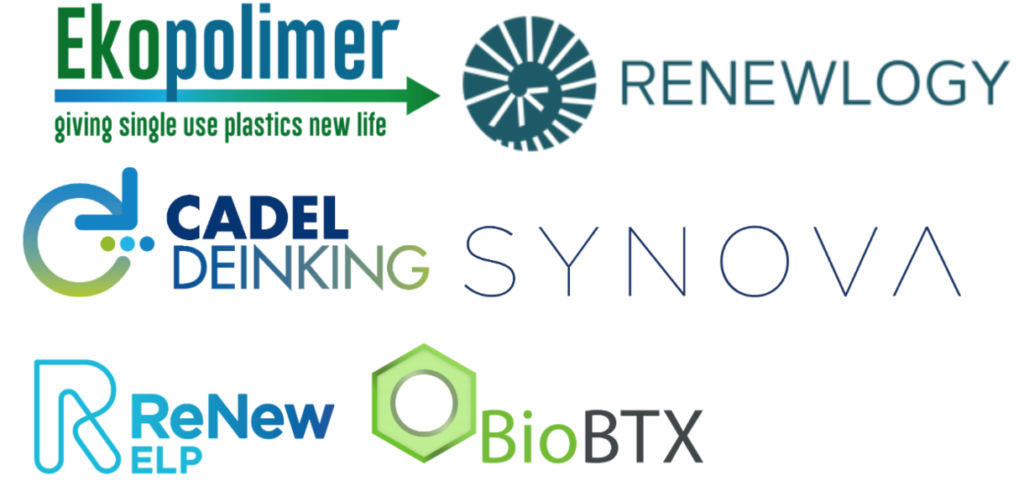
Among the five finalists, ReNewELP was selected as the final Challenge winner. RenewELP will receive a free year of membership to the SPC and enter into a mentorship program jointly run by the SPC and Closed Loop Partners.
“RenewELP submitted a detailed, transparent process description and market analysis. We were impressed with the processing capacity scale (up to 80,000 -100,000 tons per year in their initial facility) and the fact that their unique CAT-HTR technology allows for mixed waste feedstocks, including paper, PET and organics. Their modular approach considers variable material costs in different markets and their end markets for diverse hydrocarbon products like oils, waxes, and chemicals represent large market potential. RenewELP is a great fit to participate in a mentorship program run by our organizations,”
said representatives from the SPC and Closed Loop Partners in a joint statement.
The SPC & The Center for the Circular Economy at Closed Loop Partners team followed up with Richard Daley, Managing Director of RenewELP, for a post challenge interview.
Read the Q&A with Richard here
The SPC and CLP believe that all of technologies presented by the Finalists represent the kinds of diverse solutions needed for recovery of flexible packaging. We look forward to staying in touch with all the finalists and tracking and promoting their progress.
Learn more about the FlexPack Recovery Challenge.
ABOUT THE CENTER FOR THE CIRCULAR ECONOMY AT CLOSED LOOP PARTNERS
The Center for the Circular Economy brings together industry experts, academic researchers, and entrepreneurs who are solving for today’s most pressing challenges in design and reuse, providing a collaboration center for innovators to commercialize products, services and technologies that are leading the transition from a linear take, make, waste economy to a restorative one in which materials are shared, re-used, and continuously cycled.
ABOUT THE SUSTAINABLE PACKAGING COALITION
The Sustainable Packaging Coalition is a membership-based collaborative led by an independent non-profit that believes in the power of industry to make packaging more sustainable. Using an objective life-cycle-based approach, we work in a constructive atmosphere to provide thought leadership and bring our members together to strengthen and advocate the business case for more sustainable packaging.
We Can Accelerate Solutions for Plastics & Circular Supply Chains
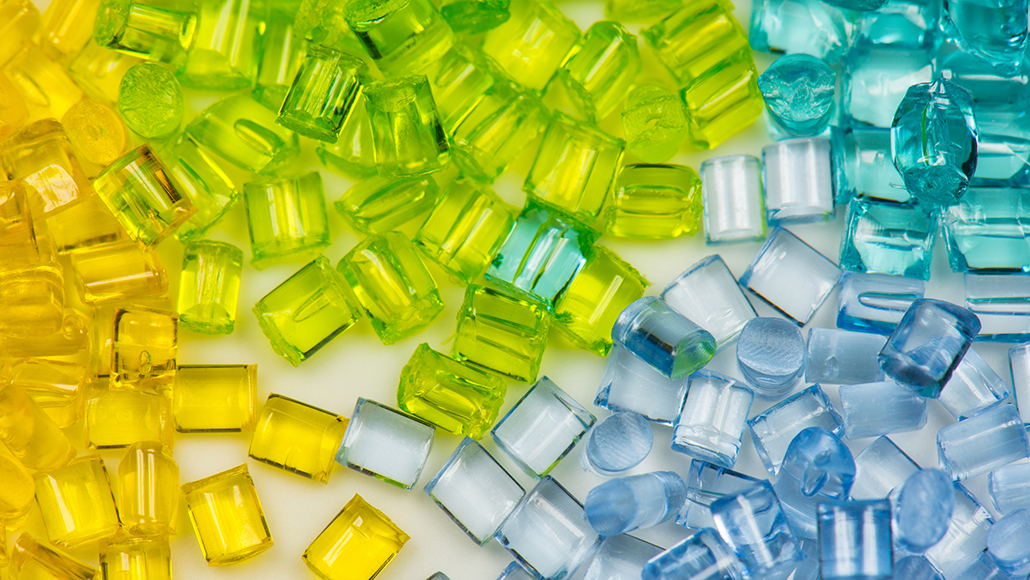
New Report Shows Tremendous Value to be Captured…. When We Stop Throwing Plastics in the Trash
The U.S. and Canada send over 34 million tons of plastics to landfills or incinerators each year. Following current trends, global plastics demand is forecasted to triple by 2050. And even more troubling, mismanaged waste leaks into our environment – there may be more plastics than fish (by weight) in our oceans by 2050.
But what if we could change that? What if we could use innovative chemical recycling technologies to purify, decompose, or convert waste plastics into the building blocks for renewed raw materials instead of discarding them after one use?
What if we could also reduce the world’s reliance on fossil fuel extraction, reduce landfill disposal costs for municipalities, decrease marine pollution, and generate billions in new revenue?
We can.
Investors and brands have an opportunity to influence and accelerate transformational technology solutions that repurpose plastics waste and keep materials in play in circular supply chains.
There are at least 60 technology providers developing these transformational technologies that purify, decompose, or convert waste plastics into renewed raw materials. This report proposes accessible, shared language to use to define and talk about each of these processes going forward:
Purification involves dissolving plastic in a solvent, then separating and purifying the mixture to extract additives and dyes to ultimately obtain a “purified” plastic. Purification processes make it possible to safely transform carpet into yogurt cups — greatly increasing the value of plastics waste. PureCycle Technologies will do just that when it opens its Ohio facility in the next year.
Decomposition is a process that involves breaking molecular bonds of the plastic to recover the simple molecules (“monomers” or “intermediates”) from which the plastic is made. In other words, plastic doesn’t just have to go back to plastic – it can become a valuable raw material to be used again. Loop Industries decomposes PET into its monomers and, with its partners, aims to produce a Loop-branded recycled PET pellet.
Conversion is similar to decomposition in that the process involves breaking the molecular bonds of the plastic. A key difference is that the output products from conversion processes are often liquid or gaseous hydrocarbons similar to the products derived from petroleum refining. These raw materials may enter different supply chains, such as fuels for combustion, and/or petrochemicals that can be made into intermediates and monomers for new plastics. Agilyx, based in Oregon, uses both decomposition and conversion technologies that can produce a variety of products, including naphtha, jet fuel, synthetic crude oil and styrene monomer, depending on the feedstock.
Through these technologies, it’s possible to recycle plastic back into plastic, AND to create valuable upstream products that keep materials in play.
The technology is possible. The question now is: How fast and how far can we go?
Every sector of society is engaged in the broad challenges of climate change and the visible problem of plastics waste. Many of the world’s largest and most influential brands are taking ownership of the problem and looking at their own supply chains. The Center for the Circular Economy at Closed Loop Partners is creating a roadmap for how to build on this momentum by unifying the diverse actors in this space and accelerating collaborative investment to bring solutions to scale.
Demand for plastics is strong and growing, yet the supply of recycled plastics available to meet demand is stuck at 6%. Options for recycling plastics today don’t capture the full opportunity: with current infrastructure, a small portion – less than 10% – of plastics waste from many consumer packages and products is recovered and recycled. Current mechanical processes and infrastructure aren’t enough to support the publicly stated goals of many global brands who have committed to use more recycled plastics in their products and packaging, or to achieve the zero waste goals of our major cities.
We surveyed more than 60 technology providers – broadly categorized as using one (or more) of three processes described above – nearly all of them at least at the lab stage of maturity, with significant potential to grow and scale. More than 40 of these solution providers are operating commercial scale plants in the U.S. and Canada today, or have plans to do so within the next two years.
But of the technology providers surveyed, it has taken them 17 years on average to reach growth scale. That’s not fast enough. More investment is needed now to accelerate these solutions – to go from “possible” to “probable”.
That’s why we are calling on investors, brands, and industry to join us in: investing to bring solutions to scale; increasing awareness of how these technologies apply to different supply chains and waste streams, including adopting the shared language from this research; and collaborating on partnerships with technology providers.
If these technologies are understood more broadly – and are more widely adopted and scaled – tremendous economic value can be realized. According to our analysis, if these technologies can meet market demands for plastics and petrochemicals, they have a potential addressable market of $120 billion ($47 billion for polymers) in the U.S. and Canada alone.
We need to stop thinking of plastics as waste, and start treating it as a resource. Until we do this, we are taking tons of value – and throwing it in the trash.
We hope you will take the time to read the full report: “Accelerating Circular Supply Chains for Plastics”. You can also see the overview of our key findings and recommendations for next steps here.
Join us: If you are interested in participating in our ongoing research, convening, and investment in this area, we encourage you to introduce yourself to the Center for the Circular Economy: [email protected].
We look forward to working together to accelerate solutions to plastics waste and circular supply chains.
